GoldFocus - FAQ
Frequently Asked Questions
- How does the GoldFocus Focusing System compare to a Bahtinov mask?
- What exactly does the GoldFocus Focusing System measure?
- Isn't all this talk about Fresnel-Kirchhoff and Nijboer-Zernike theories just marketing fluff?
- Do I need a high-quality focuser to take advantage of GoldFocus?
- How can the GoldFocus Mask be used for visual observing or film photography?
- Can I change the colors of the GoldFocus Analysis Software for better night vision?
- Can I change the voice used by the GoldFocus Analysis Software?
How does the GoldFocus Focusing System compare to a Bahtinov mask?
Compare the following images for yourself.
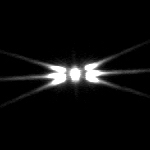 |
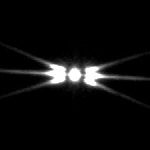 |
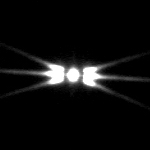 |
The three images above were taken through a Bahtinov mask at three different qualities of focus. Which of the above is the best focus? Which is the worst focus? Pause for a minute before reading ahead and decide which are best/worst and ask yourself how confident you are. Feel free to zoom in a bit, if it might help. These images are presented at their actual pixel size just as they come from the camera - no resizing.
 |
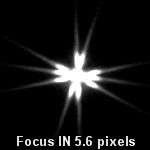 |
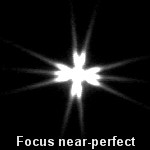 |
The three images above were taken through a GoldFocus Mask as they would be displayed in the GoldFocus Analysis Software. These three images might be in a different order, but they are the exact same three focus qualities used in the Bahtinov mask images and taken only seconds apart from the Bahtinov images by changing the mask and keeping the same focus. The GoldFocus Analysis Software tells you precisely the quality of focus and displays it on-screen, as shown above. There is no subjective judgment, just objective quality. You can see the quality of focus at a glance.
By GoldFocus standards, the "5.6 pixels" focus would be considered very poor focus, the "1.5 pixels" focus would be fair, and the "near-perfect" focus would be excellent. Good focus would be under 1 pixel and poor focus would be around 3 pixels.
If you are like most observers, you might have correctly decided the worst focus with the Bahtinov mask. You are also likely to have some uncertainty about correctly deciding on the best focus. For your information, the left Bahtinov image is very poor focus, the right is fair focus, and the center is excellent. It is quite possible you correctly identified the best/worst, but consider how difficult it really was and how confident you were. Moreover, the comparison for best was excellent versus fair. Consider how much more difficult the comparison of excellent versus good would be. With GoldFocus, focus quality is unmistakable and accurate.
What exactly does the GoldFocus Focusing System measure?
The GoldFocus Analysis Software is measuring very precise and predictable changes in the diffraction pattern of the GoldFocus Mask when focus changes. It is not enough to know how a diffraction pattern looks when it is in focus - accuracy requires sensitivity to focus changes. The GoldFocus Mask is optimized for focus sensitivity (see also Nijboer-Zernike theory) and is several times more sensitive than other diffraction masks before including the additional accuracy of objective measurement compared to subjective judgment. In other words, the GoldFocus Mask is several times more sensitive in and of itself.
The GoldFocus focus measurements are the actual size of the effects being measured, stated in pixels. For example, in the FAQ comparison to the Bahtinov mask, a GoldFocus focus measure of 1.5 pixels is illustrated. Because of the greater sensitivity of the GoldFocus Mask, the sensitivity of the Bahtinov mask is several times smaller - in fact, about 0.4 pixels for the same focus.
Which is why the GoldFocus Analysis Software can easily measure a much larger 1.5 pixels in the GoldFocus Mask whereas the human eye has a much more difficult time discerning the much smaller 0.4 pixels in the Bahtinov mask.
Isn't all this talk about Nijboer-Zernike theory just marketing fluff?
No, it is not fluff. Unlike classical Fresnel-Kirchhoff theory and Fraunhofer diffraction which assume perfect optical systems for their analysis ("a well-corrected lens" is the usually stated caveat), Nijboer-Zernike theory specially applies to all manner of deviations from perfect optical systems, including most importantly the effects of focus. Nijboer-Zernike theory is tailor-made for analyzing telescope focus.
You may be surprised to learn you are benefiting from the Nijboer-Zernike theory as you read this page on your web browser. The manufacture of many integrated circuits uses a process of microlithography which is a form of photolithography applied at scales on the order of 10 micrometers (microns). This use of microlithography involves focusing beams of light to engrave precise patterns on a semiconductor substrate, which goes on to become an integrated circuit.
Recent advances in Nijboer-Zernike theory have been partly motivated by its application in microlithography, made clear by the fact that much recent work on Nijboer-Zernike theory has been published in the professional journals of microlithography and micromanufacturing. The electronic devices on which you are reading this page have almost certainly benefited from Nijboer-Zernike theory during their manufacture.
Focusing star light onto a CCD pixel with a pixel size in the range of 5-12 micrometers (microns) is surprisingly similar to the problems of focusing engraving beams in microlithography at a scale of 10 micrometers (microns). Not only are the scales almost identical, but there is something satisfyingly poetic about using Nijboer-Zernike theory to help focus star light onto a CCD which has itself benefited from the same theory during its manufacture.
The GoldFocus Analysis System has applied this same science to the problem of accurately focusing your telescope for CCD imaging.
Do I need a high-quality focuser to take advantage of GoldFocus
No, GoldFocus works with all focusers and should help you improve focus with almost any focuser. The main difference you would experience with a high-quality focuser compared to an average focuser is the speed and convenience of achieving good focus. GoldFocus can measure focus quality very accurately and will recommend correspondingly small focus adjustments. The ability of focusers to make fine adjustments varies with focuser quality. A high-quality focuser will let you make quick, accurate adjustments and get to good focus very quickly. An average focuser might take time, patience, and maybe a little trial-and-error to get to good focus. If you take your time with an average focuser, you can almost always achieve good focus and GoldFocus will measure it, tell you, and leave no doubt about the quality.
How can the GoldFocus Mask be used for visual observing or film photography?
The GoldFocus Mask can be used without the GoldFocus Analysis Software in a manner similar to the Diffraction Cross, Modified Hartmann, or Bahtinov masks. When used without the GoldFocus Analysis Software, the objective is to center the diffraction fringes by visually assessing their location through the telescope eyepiece or a film camera viewfinder. When used without the GoldFocus Analysis Software, the GoldFocus Mask is noticeably more precise than the Bahtinov, Diffraction Cross, or Modified Hartmann masks due to the optimized design of the GoldFocus Mask. When used with an astronomical CCD or DSLR camera and the GoldFocus Analysis Software, the GoldFocus Focusing System is 10-20 times more sensitive than other focusing methods.
Can I change the colors of the GoldFocus Analysis Software for better night vision?
Yes, you can. With the exception of the Focus View of the star image which already uses black and red night vision colors, the GoldFocus Analysis Software uses a standard Windows color scheme. You can use Windows Theme Settings to change Windows colors and save them for future re-use during your imaging sessions. Refer to your Windows documentation for how to change the display color theme.
Can I change the voice used by the GoldFocus Analysis Software?
Yes, you can. The voice used by your computer is controlled by Windows. You can use the Windows Control Panel and Text-to-Speech settings to change voices. Additional voices can be downloaded from Microsoft or third party vendors. Voice support varies for Vista and Windows 7 compared to earlier versions of Windows, so not all voices will work with all versions of Windows.

